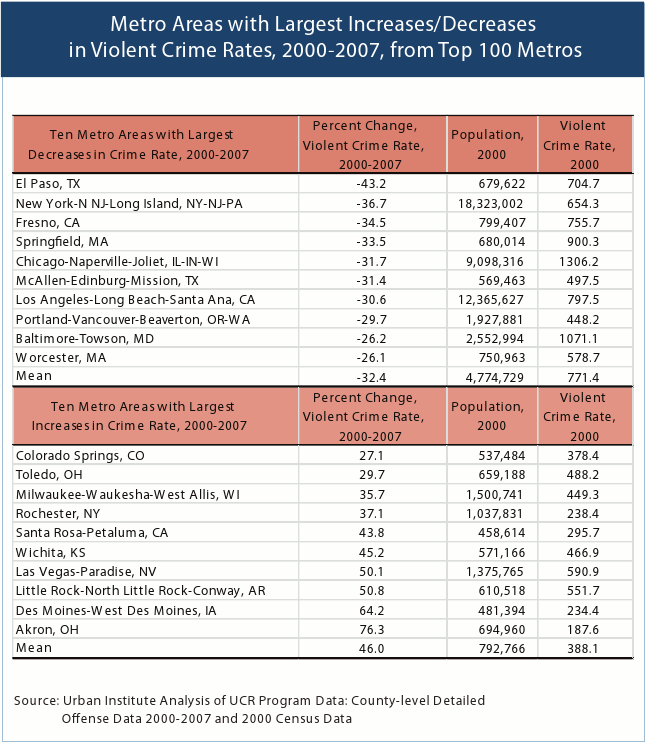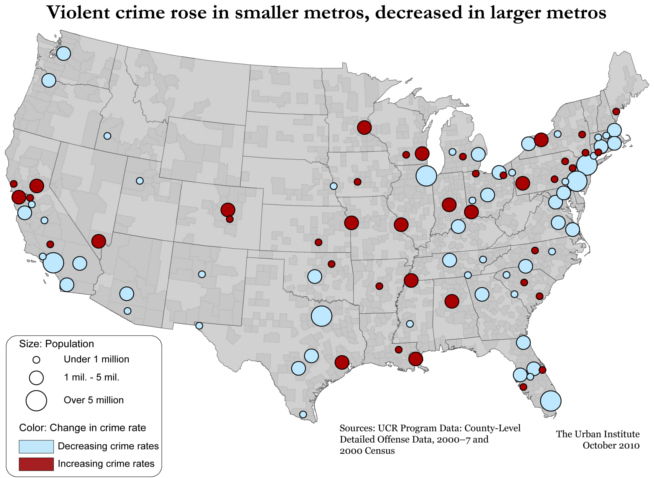
|
|
Declining Violent Crime Violent Crime: Challenging the Conventional WisdomOver the last decade, violent crime rates (homicide, rape, aggravated assault, and robbery) have been falling both nationally and in nearly two-thirds of the 100 largest metropolitan areas. Yet a recent Gallup poll found that more Americans than ever believe the crime problem is worsening. Lots of Americans also think that population growth brings higher crime and that the nation's biggest metros face worsening violent crime problems. But the facts don't support these conclusions either. Over the past decade, population growth has been concentrated in metros of the Sunbelt states, stretching from South Carolina and Florida to Arizona and California. Population declines have been concentrated in the metros of the Northeast and in the Great Lakes region. Metros with decreasing violent crime rates, however, stretched from the Northeast to Florida and from the Gulf Coast to California. Thirty seven metropolitan areas experienced increasing violent crime rates over that period, and these were scattered mainly throughout the mid-section of the country?from the Rust Belt through the Midwest to Nevada. When we compare the ten metros with the biggest increases in violent crime to the ten with the biggest declines, we find that both groups had the same average rate of population growth. The two groups of metros differ, however, with respect to their absolute size. Surprisingly, the ten metros that enjoyed the biggest declines in violent crime are almost six times larger on average than the ten that experienced the biggest increases. In fact, the ten areas with the largest crime declines include three of the five largest metropolitan areas in the United States?New York, Chicago, and Los Angeles. In addition, the ten metro areas with the biggest declines in violence started the decade with crime rates that were on average nearly twice as high as the rates in the ten metro areas with the biggest increases in violence. In 2000, the overall violent crime rate for the U.S. was approximately 506 crimes per 100,000 persons. Among the ten metro areas with the biggest declines in violence from 2000 to 2007, all but two (McAllen-Edinburgh-Mission, TX and Portland-Vancouver-Beaverton, OR-WA) had above average violent crime rates in 2000. The opposite is true for the ten metro areas that went on to experience the biggest increases in violence; only two had above average crime rates at the start of the decade (Las Vegas-Paradise, NV and Little Rock-North Little Rock-Conway, AR). In other words, violent crime is rising in smaller metros with lower crime rates and falling in bigger metros with higher crime rates. This defies the conventional wisdom that big metros are becoming more and more dangerous places to live. Both researchers and policymakers should focus more attention on the smaller metros that are experiencing rising rates of violent crime.
Data used for this analysis were compiled from the National Archive of Criminal Justice Data (NACJD), which are based on the FBI's UCR data, but incorporate adjustments to account for missing data. Many of the problems commonly associated with ranking cities or metropolitan areas using the UCR data are avoided here by comparing changes in rates over time rather than the rates themselves, which may not necessarily be comparable. It should also be noted that population figures used to calculate rates for each metro area were based only on the areas that actually reported crime to the UCR program, not for the entire county. The NACJD data have a number of additional caveats, explained in detail here. |
Experts Feedback
Send us your comments to help further the discussion. Share
Commentaries
|





